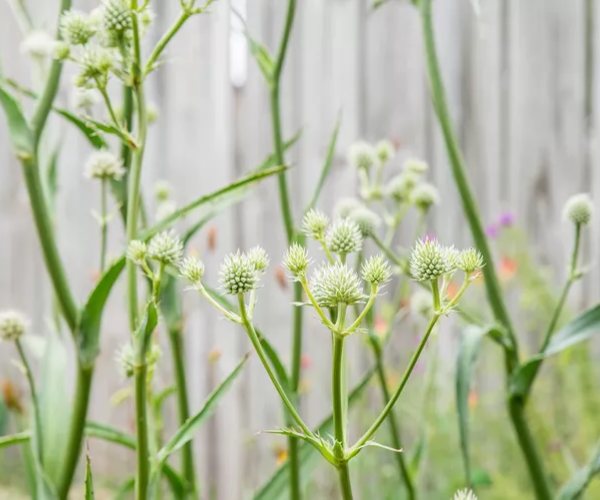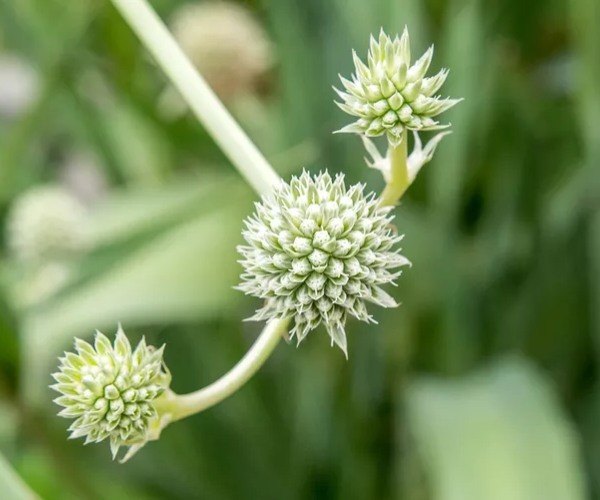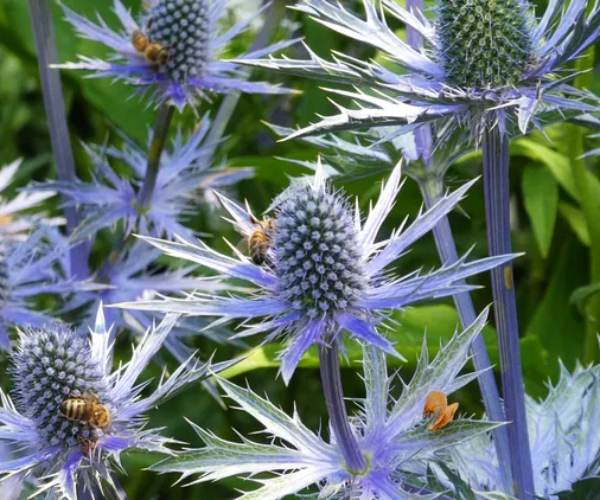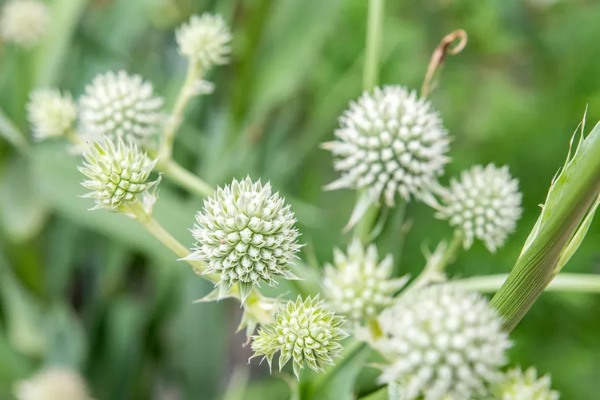For those who don’t know sea holly is an easy-to-care-for, long-lived perennial from the carrot plant family(Apiaceae). It consists of dark green leaves and produces taller flowers with stems featuring dark purple-blue flowers. the flowers resemble small glowing thistles and they often bloom from midsummer until fall.
These plants grow best in dry to medium sandy soil in a location that gets full sunlight, for at least eight hours. It’s hardy in USDA zones 5 to 9, down to -20 degrees Fahrenheit. Once fully established, this plant needs to be watered only when it’s dry because it has a long taproot that makes it drought-resistant. Sea holly is a self-sowing plant. It is also non-invasive as it can be removed easily.
Plant Attributes
- Common Names: Sea holly, blue sea holly, star thistle
- Botanical Name: Eryngium planum
- Family: Apiaceae
- Plant Type: Herbaceous, perennial
- Mature Size: 2–3 ft. tall, 1–2 ft. wide
- Sun Exposure: Full
- Soil Type: Sandy, well-drained
- Soil pH: Acidic, neutral, alkaline
- Bloom Time: Summer, Fall
- Flower Color: Blue, Purple
- Hardiness Zones: 5–9 (USDA)
- Native Area: Europe, Asia
Sea Holly Care
Sea Holly plants are super easy to take care of if you just provide the proper soil and sun conditions. Plant sea holly in dry to medium sandy soil in an area that gets full sunlight. Once you plant it, a little tending needs to be given. Most varieties start flowering in midsummer and will continue to flower in the fall as well.

Also, Read Green Guardians: These 12 Plants Can Improve Your Soil Quality
Here are some of the main requirements for growing a sea holly:
- Plant sea holly in a full sun-area in a forever spot because it has taproot which makes it difficult to transplant.
- This plant tolerates irregular water because it is drought-resistant.
- It likes sandy, well-drained soil and is salt tolerant.
- It requires support when grows tall; plants next to other tall plants like coneflowers.
- It handles fluctuations in temperature and humidity well in USDA zones of 5 to 9.
- It doesn’t require fertilizer and can easily handle poor soil.
Light
Sea holly enjoys a full day of sun for at least 8 hours, giving you the best version of the plant and its most prolific blooms. The plant can handle partial shade as well but as a result, the stems may be weaker, making it necessary to stake the plants to keep them straight.
Soil
The best soil for sea holly is well-drained, sandy, and fertile (poor to moderately fertile). It has a good tolerance for salty soil and does great coastal gardens. Rich soil can sprawl hollies. Other than that, good drainage is necessary so add compost to amend compact soil.
This plant is not fussy about its soil pH. It tolerates anything around the neutral range of 6.1 to 7.8. That being said, sea hollies need good drainage otherwise it can be prone to root rot and die off.
Water
Due to the long taproot, sea hollies become drought-tolerant once established. They don’t require extra watering unless subjected to a prolonged drought at the peak summertime. Do not keep sea hollies near plants that require more water because the excess surface moisture can cause the flower’s crown to rot.
While watering, aim the water source at the plant’s base to reduce the risk of built-up moisture.
Temperature and Humidity
As long as you plant it with proper hardiness range (zones 5 to 9), sea holly has no extra temperature or humidity needs. It will do better in the cooler days of spring and fall.

Fertilizer
Luckily, these plants are not fertilizer fans. Excess fertilizer can make the plant sprawl. You can plant these where there is poor, moderately fertile soil in your garden.
Types of Sea Holly
Here are some varieties of sea holly:
- ‘Big Blue’: This variety has iridescent, spiky 4-inch blue blooms and silvery foliage. It grows 18 to 24 inches tall and wide.
- ‘Jade Frost’: This is a variety that boasts variegated foliage with pink margins and veins.
- ‘Blue Glitter’: This is a bountiful variety with dozens of blooms per plant and gray-blue foliage.
- ‘Sapphire Blue’: This is a classic favorite with striking blue flowers and leaves.
- ‘Tiny Jackpot’: This is a petite variety that grows to just 14 inches tall and looks good at the front of a border.
Other types of Eryngium plants
Eryngium species have a historical significance as they have been used in traditional medicine for treating kidney problems. Multiple research has shown that Eryngiam has antioxidant and anti-inflammatory properties. This plant is non-toxic to humans and some quantities of the shoots and leaves of this plant are edible.

This genus has more than 150 species many are common garden plants. They all have identical metallic blue flowers but the sizes of some blossoms may vary. Some common species include:
- E. alpinum (alpine sea holly) is a 30-inch tall plant, hardy in zones 2 to 8.
- E. giganteum (giant sea holly) grows to 4 feet tall and is hardy in zones 4 to 7.
- E. variifolium (Moroccan sea holly) is an 18-inch tall plant, hardy in zones 5 to 9.
- E. bourgatii (Mediterranean sea holly) has smaller stature (24 inches) and smaller flowers. It is hardy in zones 5 to 9.
Pruning
It is known that sea holly will bloom longer if you deadhead the spent flowers. It is best to prune the plants near ground level after the growing season is gone. But since the flowers last till winter, you can leave the fall flowers on the stems.

Propagating sea holly
Spring is the best time to plant mature sea holly. This plant will grow quickly and semi-mature nursery plants will flower in the first season. If you sow seeds in late summer or fall, they will germinate in spring.
As mentioned above, the tap roots of sea holly can make it somewhat difficult to transplant. But it is still possible to do so via root cuttings and here is how:
- Dig up the plants carefully in late summer (taproot and all), then cut away healthy sections of roots (but remember never to cut away more than one-third of the plant’s total root mass).
- Replant the parent clump right after, then plant the individual root sections in a small container filled with compost and vermiculite. Make sure the root segment’s cut end (crown side) is facing up. The root segment should be entirely covered but the cut tip should barely be under the surface.
- Overwinter the pots in an inside location. In spring, the root segments should begin to generate new roots, which you will see coming out of the bottom of the container.
- Once a network of roots is established, and green shoots emerge above the soil line, you can transplant your new sea holly plant into the garden in a spot that gets full sun.
Planting sea holly from seed
There are many sea holly varieties that we can start from seed. However, this process has a few steps. The seeds will do best if we stratify them before sowing. The best and easiest method of planting is to sow the seeds in the soil in the fall. After that, wait patiently till the spring.
You can start planting sea holly indoors if you want.
- Collect seeds in the fall, chill them for about four weeks in the refrigerator.
- Plant them in small containers filled with a sandy potting mix.
- Germination can take one week to a month. Germination can take up to 90 days when sown directly, considering the cold season.
- The seedlings can be planted outdoors the following spring when frost has passed. As with many perennials, these seedlings may take most of the first growing season to establish good root systems—in coming years, you can expect them to flower at the expected time.
Common Pests and Diseases
In dry soils, sea holly is normally free of nearly every type of pests and diseases. But damp soil can make the plant prone to fungal diseases like leaf spot and root rot. Powdery mildew can be a problem. Watering only the base and providing good air circulation will minimize mildew infection. Moist condition will also make aphids, slugs, and snails to feed on the foliage.
In case of serious leaf spot disease, fungicides may help to solve the problem. You can normally control aphids with horticultural oil (or ignore them since the damage is rarely severe). You can remove slugs and snails with your hands or control them with baits.
FAQs
Q: Where are the best places to use sea holly in the landscape?
A: Sea holly is one of the best choices for sun-baked areas of the garden that are difficult to water. You can plant them individually or in small groups.
Sea holly is famous with bees and butterflies but not with deer and rabbits. In a cut arrangement, the flowers last several days.
Q: How long does sea holly bloom?
A: Sea holly normally blooms from mid-summer to fall. To prolong blooms or encourage more blooms, deadhead spent flowers.
Also, Read How to Grow and Care for Sesame Plants!
